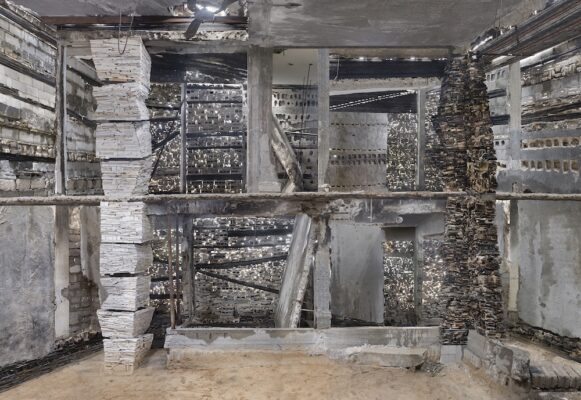Search
To search for an exact match, type the word or phrase you want in quotation marks.
A*DESK has been offering since 2002 contents about criticism and contemporary art. A*DESK has become consolidated thanks to all those who have believed in the project, all those who have followed us, debating, participating and collaborating. Many people have collaborated with A*DESK, and continue to do so. Their efforts, knowledge and belief in the project are what make it grow internationally. At A*DESK we have also generated work for over one hundred professionals in culture, from small collaborations with reviews and classes, to more prolonged and intense collaborations.
At A*DESK we believe in the need for free and universal access to culture and knowledge. We want to carry on being independent, remaining open to more ideas and opinions. If you believe in A*DESK, we need your backing to be able to continue. You can now participate in the project by supporting it. You can choose how much you want to contribute to the project.
You can decide how much you want to bring to the project.

Since the 90s of the last century, the spread of memory practices in art and literature has been enormous. These memory practices manifest themselves around issues such as trauma, war, Holocaust and other genocides, migration, but also in the increasing use of archival organisations combined with media and genres like photography, documentary film and video. A real archival fever has come about. The primary question raised by this flourishing of memory and archival practices, which intend to reanimate lost or invisible knowledge and memories, is if we should see this as a celebration of memory, as a fin de siècle, and in the meantime un debut de siècle, as an expression of the desire to look backwards, or, in contrast, as a symptom of a severe memory crisis or a fear of forgetting lost origins and traditions? The distinction I just made resonates with the one Svetlana Boym made in her famous book The Future of Nostalgia from 2001, namely the one between restorative nostalgia and reflective nostalgia.[1]Svetlana Boym, The Future of Nostalgia (New York: Basic, 2001) I will refer several times to Boym because her work does still offer the most thorough and relevant understanding of nostalgia I know of. Boym defines nostalgia as a longing for a home that no longer exists or has never existed. Nostalgia is a sentiment of loss and displacement, but it is also a romance with one’s own phantasy. This dual side of nostalgia is already present in the two Greek roots in the word nostalgia: νόστος, nóstos (“return home”) and ἄλγος, álgos (“longing”).
Restorative nostalgia stresses nóstos (home) and attempts a transhistorical reconstruction of the lost home. Reflective nostalgia thrives in álgos, the longing itself, and delays the homecoming—wistfully, ironically, desperately. It is rather obvious that in Boym’s typology restorative nostalgia is negative and the reflective one is positive.
Restorative nostalgia expresses itself in terms of the truth about origins and tradition. It is deadly serious and often fanatic. It deploys two different narrative plots: the first one is the return to origins, the second one of conspiracy as an explanation for the present. The pursuit of lost origins and traditions can be seen as a definition of the extreme right in Israel, the Netherlands, France, the United States and probably all over the world. They refuse contemporary developments like globalization and migration and long back to an imagined past in which these phenomena did not yet exist. Although migration is not a recent phenomenon because it has been going on since the rise of capitalism and colonization, the extreme right ignores this history and longs back to pre-modern times when people were still located in their own small, homogeneous, and quiet community.
It makes little sense to understand the rise of the extreme right as the cause of the recent archival fever, or the other way around, that archival fever has resulted in the rise of the extreme right. This kind of simplistic causality defines conspiracy theory that the extreme right often makes use of. Let’s try to understand the negative, conservative role of restorative nostalgia and how it defines certain archival practices. Allow me to quote Svetlana Boym once more in order to better understand the politics of the extreme right:
nostalgia is not always retrospective; it can be prospective as well. The fantasies of the past determined by the needs of the present have a direct impact on the realities of the future. Considering the future makes us take responsibility for our nostalgic tales. Unlike melancholia, which confines itself to the planes of individual consciousness, nostalgia is about the relationship between individual biography and the biography of groups or nations, between personal and collective memory. While futuristic utopias might be out of fashion, nostalgia itself has a utopian dimension, only it is no longer directed toward the future. Sometimes it is not directed toward the past either, but rather sideways. The nostalgic feels stifled within the conventional confines of time and space.[2]Svetlana Boym, “Nostalgia and Its Discontents, in: Atlas of Transformation, Nostalgia | Svetlana Boym (monumenttotransformation.org)
During the 1990s my scholarly publications and teaching mainly focused on Holocaust trauma and memory. I was even accepted in the community of Holocaust studies as an “honorary Jew”. However, more and more I felt uncomfortable by how the memory of the Holocaust was used by right-wing politicians in Israel for imagining a future Israel.[3]See e.g. my books Caught by History: Holocaust Effects in Contemporary Art, Literature, and Theory (Stanford UP 1997), and Art in Mind. How Contemporary Images Shape Thought. (University of Chicago … Continue reading So, in the 21st century I decided not to contribute anymore to the field of Holocaust studies. And now in 2023 and 2024 my bad dreams of a monstrous future have been realized with the archival, genocidal practices that take place in Gaza and on the West bank.
As I have argued in my book Caught By History, modern genocides like the Holocaust are archival. They kill people not arbitrarily but on the basis of fixed, usually ethnic or religious categories that are also used in other archival organisations. And in the Holocaust not only human beings were archived (Jews, Romas, homosexuals) but also their belongings; the storages of Auschwitz euphemistically called “Canada” show the frightening results of this archival practice. The role of restorative nostalgia in this archival practice is, again, well described by Boym:
The danger of nostalgia is that it tends to confuse the actual home with an imaginary one. In extreme cases, it can create a phantom homeland, for the sake of which one is ready to die or kill. Unreflected nostalgia breeds monsters. Yet the sentiment itself, the mourning of displacement and temporal irreversibility, is at the very core of the modern condition.[4]Svetlana Boym, “Nostalgia and Its Discontents, in: Atlas of Transformation, Nostalgia | Svetlana Boym (monumenttotransformation.org)
The current genocide in Gaza is the result of restorative nostalgia, the longing back to a collective memory of the time when only Jews lived in Palestine. This was never really the case, because that area was populated by several ethnic communities. It is a phantom homeland. But when we take the fiction (lied truth) of the Old Testament as historical text, one can begin using it as an origin for restorative nostalgia. Because when Palestine is for the Jews an imaginary home, although it “never really existed” to use Boym’s words once more, it is more important than ever to understand the productive role of reflective nostalgia.
Boym considers nostalgia as a side product of modernity. This does not make modernity as such problematic because there is also a tradition of critical reflection on the modern condition that incorporates nostalgia. She calls it “off-modern.” The adverb “off” confuses our sense of direction; “it makes us explore side-shadows and back alleys rather than the straight road of progress; it allows us to take a detour from the deterministic narrative of 20th‑century history. Off-modernism offered a critique of both the modern fascination with newness, and the no less modern reinvention of tradition. In the off-modern tradition, reflection and longing, estrangement and affection go together.”[5]Svetlana Boym, “Nostalgia and Its Discontents, in: Atlas of Transformation, Nostalgia | Svetlana Boym (monumenttotransformation.org)
Nostalgia, as a side-product of modernity, is paradoxical because it contains reflective as well as restorative nostalgia. This means that the universality of longing can make us more empathetic toward fellow humans,
yet the moment we try to repair “longing” with a particular “belonging”—the apprehension of loss with a rediscovery of identity and especially of a national community and a unique and pure homeland— we often part ways and put an end to mutual understanding. Álgos (longing) is what we share, yet nóstos (the return home) is what divides us.[6]Svetlana Boym, “Nostalgia and Its Discontents, in: Atlas of Transformation, Nostalgia | Svetlana Boym (monumenttotransformation.org)
What kind of conclusions can we draw now about nostalgic archiving? The answer will depend on how archives are being made or used, what kind of archival practice is being performed. The archive can be used for restorative nostalgic goals; the result of such a practice can be monstrous as the present situation in Palestine demonstrates. But the same archive can also be used reflectively; then we understand the longing without its object: a unique, pure homeland. Only when Israel and its allies start doing that can we begin imagining a possible future for Israel and Palestine.

Cover image and above: Marjan Teeuwen. From the series “Destroyed House Gaza” (2017)
| ↑1 | Svetlana Boym, The Future of Nostalgia (New York: Basic, 2001) |
|---|---|
| ↑2, ↑5, ↑6 | Svetlana Boym, “Nostalgia and Its Discontents, in: Atlas of Transformation, Nostalgia | Svetlana Boym (monumenttotransformation.org) |
| ↑3 | See e.g. my books Caught by History: Holocaust Effects in Contemporary Art, Literature, and Theory (Stanford UP 1997), and Art in Mind. How Contemporary Images Shape Thought. (University of Chicago Press, 2005) |
| ↑4 | Svetlana Boym, “Nostalgia and Its Discontents, in: Atlas of Transformation, Nostalgia | Svetlana Boym (monumenttotransformation.org) |

Ernst van Alphen is professor emeritus of Literary Studies at Leiden University. Before he was Queen Beatrix Professor of Dutch Studies at UC Berkeley. His publications include: Seven Logics of Sculpture. Encountering Objects Through the Senses (Valiz 2023); Productive Archiving. Artistic Strategies, Future Memories, Fluid Identities (Ed. Valiz 2023); Shame and Masculinity (ed. Valiz 2021); Failed Images: Photography and Its Counter-Practices (Valiz 2018); Staging the Archive: Art and Photography in Times of New Media (2014); Art in Mind: How Contemporary Images Shape Thought (2005); Francis Bacon and the Loss of Self (1992); Caught by History: Holocaust Effects in Contemporary Art, Literature and Theory (1997).
"A desk is a dangerous place from which to watch the world" (John Le Carré)